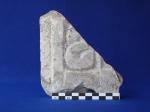Illustrations
- No uploaded files
Descrizione
- Medieval low relief
- White marble
- 1
- 14.0
- 12.5
- 4.0
- Medieval fragment with one surface carved in low relief. The opposing face was finished almost to a polish. Other faces were only roughly finished and have suffered major breaks. There is discolouration in a vein-like pattern on all surfaces.
- A small fragment of the corner of a much larger block. A guilloche pattern comprised of two flat bands in extremely low relief was carved on one face. The simple motif is flanked by a broad flat band (1.5 cm) and a narrow (with a pointed profile) raised band.
- Guilloche patterns of various kinds (i.e. comprising flat-faced ribbon-like bands, bisected bands, trisected bands) were among the stock patterns of the period. In his discussion of low relief in Liguria, Paolo Verzone points out that the motif was common in Greece and Central Italy already in the seventh century (Verzone 1945, 161). Early examples in Rome include a band below an eighth-century inscription on an architrave from S. Adriano (Stella Arena, et al. 1994, 483–86, IV.2.a–f). Guilloche bands often bordered and delineated patterns within a single slab and filled narrow spaces and interstices. See, for example, several pieces now housed in Rome's Museo dell'Alto Medioevo (Melucco Vaccaro and Paroli 1995, nos 28, 30, 31, 33, 34a, 34b, 35 and 54b) and well head housed in Berlin's Museum für Byzantinische Kunst (no. 2924, http://www.smb-digital.de/eMuseumPlus?service=ExternalInterface&module=collection&objectId=1485653&viewType=detailView).

![Download [view]](/villamagna/ark//skins/villamagna/images/results/download_sml.png)
